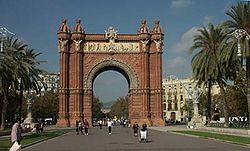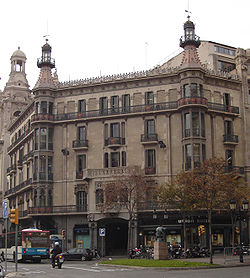
Josep Vilaseca i Casanovas
Encyclopedia


Barcelona
Barcelona is the second largest city in Spain after Madrid, and the capital of Catalonia, with a population of 1,621,537 within its administrative limits on a land area of...
1848–1910) was a Catalan
Catalan people
The Catalans or Catalonians are the people from, or with origins in, Catalonia that form a historical nationality in Spain. The inhabitants of the adjacent portion of southern France are sometimes included in this definition...
architect and artist who formed part of the Modernista
Modernisme
Modernisme was a cultural movement associated with the search for Catalan national identity. It is often understood as an equivalent to a number of fin-de-siècle art movements, such as Art Nouveau, Jugendstil, Secessionism, and Liberty style, and was active from roughly 1888 to 1911 Modernisme ...
movement.
He studied architecture in Madrid
Madrid
Madrid is the capital and largest city of Spain. The population of the city is roughly 3.3 million and the entire population of the Madrid metropolitan area is calculated to be 6.271 million. It is the third largest city in the European Union, after London and Berlin, and its metropolitan...
and qualified in 1873. He travelled with Lluís Domènech i Montaner
Lluís Domènech i Montaner
Lluís Domènech i Montaner was a Spanish Catalan architect who was highly influential on Modernisme català, the Catalan Art Nouveau / Jugendstil movement. He was also a Catalan politician....
in Germany. By 1874 he was already teaching at the Escuela de Arquitectura de Barcelona, a post he held for the rest of his life.
Amongst his best-known works is the Arc de Triomf
Arc de Triomf
The Arc de Triomf is an archway structure in Barcelona, Spain. It was built for the Exposición Universal de Barcelona , as its main access gate by architect Josep Vilaseca i Casanovas.The arch is built in reddish brickwork in the Neo-Mudéjar style...
in Barcelona, built for the 1888 Universal Exposition. His work is a textbook case of the evolution of late neo-Classicism into Modernisme which took place in Catalan architecture towards the end of the 19th century.
Other notable works:
- Casa Vilaseca, Plaça Urquinaona, 1874. No longer exists.
- Institucions Provincials de Cultura, jointly with Lluís Domènech i MontanerLluís Domènech i MontanerLluís Domènech i Montaner was a Spanish Catalan architect who was highly influential on Modernisme català, the Catalan Art Nouveau / Jugendstil movement. He was also a Catalan politician....
, 1877. - Casa Pia Batlló, in Rambla de Catalunya, 1901.
- Casa Comas i Argemí, in Avinguda de la República Argentina, 1909.
- Casa Cabot, in Carrer de Lloria, 8, 1906.
- Cases Batlló, on the corner of Carrer Mallorca and Passeig de Gràcia.
- Casa Bruno Quadros, in the Rambla.

